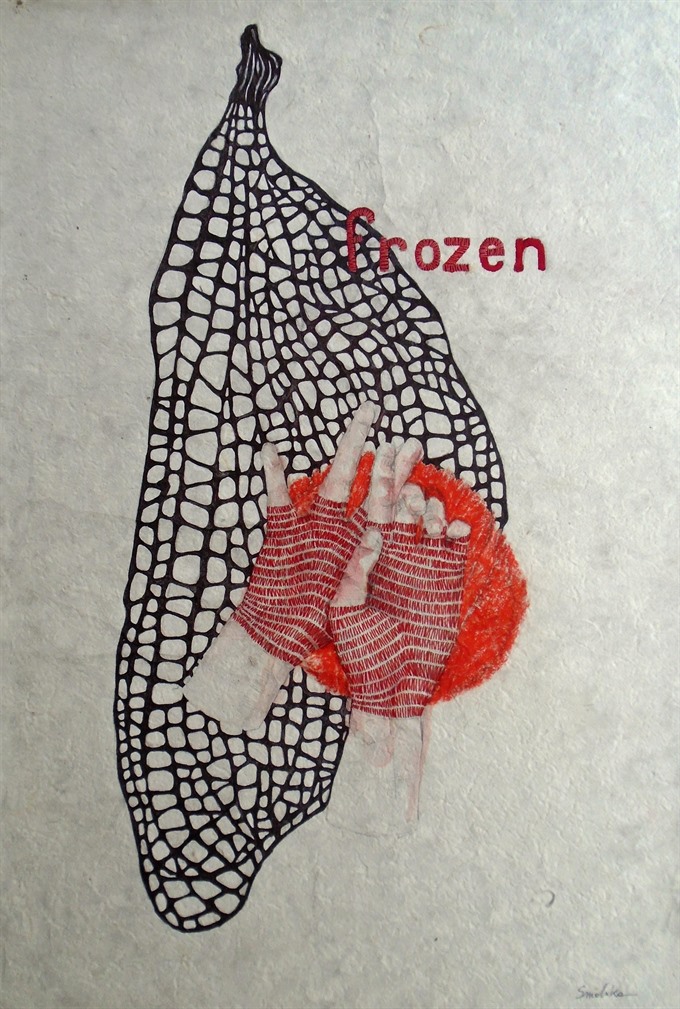Viet Nam News
By Minh Thu
Comparing herself to a sponge, French artist Marianne Smolska’s inspiration is derived from all that’s around her.
She has travelled all over world but decided to settle in Viet Nam where she discovered the endless motivation to create using the materials that fascinate her. With ink on traditional paper combined with embroidery, she expresses both feminity and strength through the issues she addresses in her works.
Smolska was born in 1969 in France. She initially studied social sciences and anthropology, but in 1994, she turned her back on anthropology for painting and graphic arts. At that time, she travelled to Naples, Italy, and settled in a studio.
She visited Viet Nam for the first time in 2011, and decided to return to live and work in Ha Noi
“The discovery of this country has been a very beautiful experience,” Smolska said in English.
“I have been very touched by the culture of this country, its history, the beauty of landscapes and especially the kindness and sense of welcome of Vietnamese people.”
Haunting past
Smolska has always been sensitive to issues related to history and social affairs, which is probably due to her former studies in anthropology, she said.
When she was a child, she lived in an eastern part of France that had been witness to terrible battles during the First World War. The forest near her house is still covered with the deadly legacy of war: trenches, craters and bullets scattered over the terrain. As a child, she sometimes thought she heard the ghosts of dead soldiers talking, and during the Second World War, trains carrying deportees crossed the landscape on their way to Nazi concentration camps.
 |
| Frozen: An artwork combining ink on handmade paper and traditional embroidery by Smolska. |
”So for me the place where I grow up was full of ghosts and it became the soil of my inspiration and motivated my desire to paint,” said Smolska.
“I know the injuries of history are also still present in the Vietnamese society. In every country who has faced war, children hear the voices of soldiers, of all those who have disappeared in the chaos of history.”
Painting and drawing are an absolute necessity for Smolska as searches for a meaning of life.
Sympathy with Vietnamese culture
When Smolska arrived here, she felt a long way from her own culture, but somehow in an environment that was familiar to her.
“So different but strangely so close,” she said.Understanding parts of Vietnamese culture is a daily interest for her.
“The Vietnamese culture is rich and complex, so the more I know, the less I understand. It’s a paradox.”
Smolska discovered the handmade paper in Viet Nam and Laos, a very beautiful material, she said.
“I waited a while before working on this material that fascinated me. Step by step, I tamed it, with ink, paint, ballpoint pen and then embroidery.”
“This paper, both fragile and resistant, allows the use of different techniques,” she said.
The idea of using embroidery probably came to her from her experience of Vietnamese culture.
“There is indeed here a traditional practice of embroidery that has somewhat disappeared in Europe. It was interesting for me to combine my way of expression with materials and techniques from Vietnamese culture,” she added.
As a graphic designer, she works for a permanent exhibition at the Old Quarter Cultural Exchange Centre at 50 Dao Duy Tu Street, Ha Noi. The exhibition focuses on the history and the cultural heritage of Ha Noi’s Old Quarter.
“I was in charge of designing graphics and signage for this exhibition. It was a very rewarding experience for me,” she said.
Of her works currently on display at Dong Phong Gallery, many were inspired by her immersion in Vietnamese culture. Some use the cloud patterns found in pagodas while others draw inspiration from fauna such as the roots of betel nut trees and flowers. The exhibition is running until June 23 with the title Phu Du (Ephemeral), and is also inspired by the spiritual dimension of worshipping ancestors and deities.
Smolska loves life in Viet Nam, and has many friends who are painters, movies directors and musicians.
“The dialogue with all those people is very rewarding for me, for two main reasons, art and human,” she said.
She has taken classes in Vietnamese but it’s a very difficult language for Europeans to grasp, she said.
“This difficulty with the Vietnamese language is my biggest frustration. But thanks to the kindness of the people here, the communication often goes through a nonverbal, very touching relationship.”
She has also hired a small studio near Ton Duc Thang Street in a little courtyard with lots of plants and trees. The owner, an old man, lives in the same building, and often invites her to drink green tea.
Every day, she goes to the street markets to buy food like other Vietnamese housewives. She also often eats pho (noodle soup), bun cha (rice vermicelli with grilled pork) and bun dau mam tom (fermented shrimp paste with fried tofu and rice vermicelli).
“I love living in this country and especially living among the Vietnamese, such an endearing people,” said Smolska. — VNS